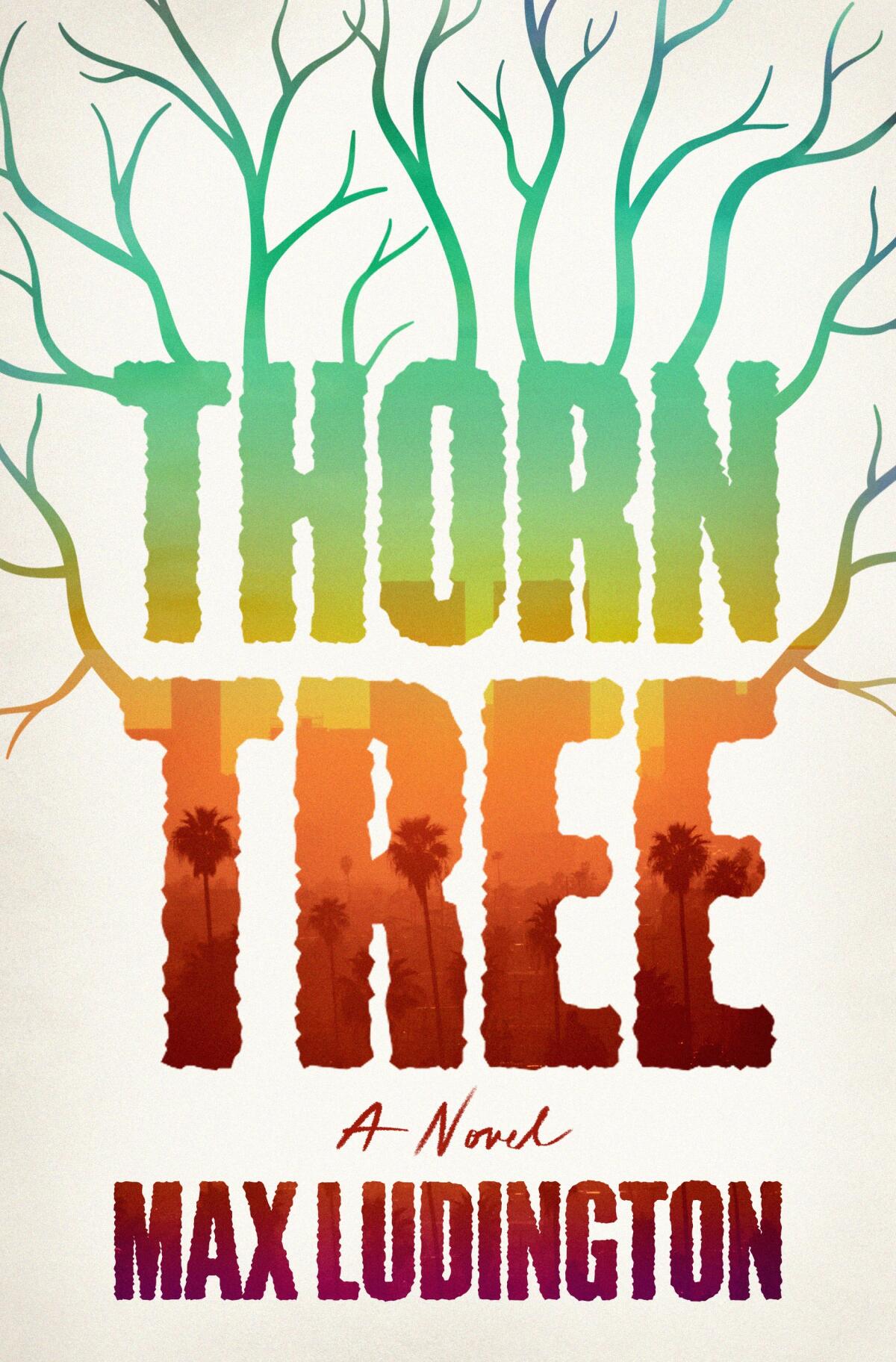Reckoning with long shadow of 1960s counterculture

- Share via
Book review
Thorn Tree
By Max Ludington
St. Martin’s Press: 400 pages, $29
If you buy books linked on our site, The Times may earn a commission from Bookshop.org, whose fees support independent bookstores.
The long shadow of the 1960s looms over “Thorn Tree,” a sprawling second novel by Brooklyn-based author Max Ludington. Set largely in Los Angeles in 2017, the book concerns two baby boomers dealing with the fallout from their countercultural pasts. It’s a novel of regrets and reckonings, traumas repressed and returning. Commentary on the allure of dangerous subcultures, combined with fleeting references to the Trump administration, suggests that the conflicts and divisions of the 1960s remain, awaiting a moment to reemerge.
The “Thorn Tree” of the title is a gigantic figurative sculpture welded in the Mojave Desert in the mid-1970s by a young man named Daniel. His art is the product of an existential crisis sparked by the mysterious death of his girlfriend, Rachel, as well as a stint in prison for LSD possession. On his release, Daniel rediscovers his creative purpose just as his outlook reaches a nadir. The work that results brings him art-world fame, followed a few years later by national notoriety when he decides to literally blow it all up.

In 2017, when the novel begins, Daniel is retired and living in Beverly Hills next door to a rising young actress, her son and her offbeat father, Jack — another 1960s casualty, though from the seamier side of the psychedelic tracks. Celia, the actress, is in Arizona playing the lead in a “surrealist, sci-fi Anna Karenina reboot” and sleeping with her married driver, Leo. Grampa Jack stays at home, ostensibly looking after 6-year-old Dean, though he doesn’t always have the boy’s best interests at heart. Gradually, we learn that the connection between Daniel and Jack is more than merely neighborly. Flashbacks to 1969 reveal the shared significance of a fateful Grateful Dead concert, a hippie commune in Marin County and a death cult that offers its disciples a dangerous kind of absolution. With Jack’s behavior becoming more erratic, long-buried secrets threaten to come out.
Twenty-one years have passed since Ludington’s first novel, the well-reviewed “Tiger in a Trance.” It too took the countercultural revolution as its subject, adopting the perspective of a young Deadhead taking more and heavier drugs till something ultimately has to give. In “Thorn Tree” Ludington gives himself a much larger historical canvas to play with and essays some more complex techniques. The story ranges across time and place. The safety of a single first-person persona is eschewed in favor of a series of close-third-person viewpoints. Most challenging, perhaps, are the tragical-mechanical challenges of the plot.
The publishing world has been unfriendly to writers of color. In her new novel, Alvarez demands we hear the stories that don’t make it to print.
Unfortunately, “Thorn Tree,” like Daniel’s early attempts at sculpture, creaks and buckles under the weight of its contrivances.
The problems are both structural and tonal. Ludington’s main plot concerns the tragedy of Daniel and Jack, yet nearly a quarter of the book is told from Celia’s perspective. Not a problem in itself, except that so much of what happens to her, including her desultory affair with Leo, is superfluous to the principal story line, doing little to complicate or complement it. As if acknowledging this, Ludington relegates her to a narrative back seat in the book’s second half as the death-cult subplot, which does bear on Daniel and Jack’s futures, comes to the fore.
This plot line requires the introduction of new characters including an alienated teenage boy who stumbles on a book about the cult’s philosophy in a yard sale, and his troubled girlfriend. These latecomers disrupt the book’s established range of perspectives and further threaten its cohesiveness.
Toby Lloyd’s debut “Fervor” raises more questions than it answers and leaves us pondering.
Backed into a corner by the mechanics of his close-third-person style, Ludington is forced into flights of self-consciously purple description to explain how the cultists think: “Sitting still outside for any length of time should have been torture for him, but with the Destination in sight he found he could let go and allow himself to experience the convolutions and obscurities of Truth and illusion — interwoven so closely, sometimes seamlessly. The riptide-power of the world against his leaky boundaries didn’t threaten him as it usually did.” Passages like this do little to convey the seductive power of a cult nor to convince the reader why anyone would ever believe such things.
The Celia/Hollywood chapters are the main source of the book’s tonal inconsistencies. Most of the characters in these scenes are hackneyed, by-the-numbers types, the mad-genius director of Celia’s movie coming over as little more than an assemblage of chauvinist clichés. (The idea that two sequels to his Tolstoy-inflected space opera would be greenlighted while the first movie is behind schedule and in constant rewrites also seems unlikely.) Other flimsy caricatures orbiting Celia include a sardonic gay best friend, a ruthless agent and a debonair old flame. At times they feel like they wrote their own parts.
The historical sequences, though generally better, don’t quite escape the cartoon treatment. “What’s tonight? You serious? The Dead are playing the Fillmore!” one character exclaims, as if the late 1960s required clearer signposting even than the tableaux of “thick-maned men in jeans and beads, willowy women shorn of inhibition, whispering through the grass, all touching each other easily, draping themselves over each other on the warm earth.”
All of this undercuts the dramatic heft of Daniel and Jack’s story.
A list of the book’s flaws overlooks passages of very strong writing, not to mention some lovely resonances and patterns that Ludington weaves skillfully into the narrative. The complicated relationship between Daniel and his sometime lover, Tanya, is nuanced and touchingly observed. Rachel’s promise, on the unknowing cusp of death, to return to Daniel chimes powerfully with Jack’s obsession with reincarnation. And the glimpsed suicide of Jack’s father hints at the latent American berserk pulsing beneath the book’s surface. Here is the high-minded tone Ludington seems to be seeking.
But in the end, he has to work too hard to smooth over the coincidences and plot machinations that drive “Thorn Tree” forward. It emerges somehow both half-baked and overdone; an inorganic assemblage, like the sculpture of its title, in which all the joins are visible.
Charles Arrowsmith is based in New York and writes about books, films and music.
More to Read
A cure for the common opinion
Get thought-provoking perspectives with our weekly newsletter.
You may occasionally receive promotional content from the Los Angeles Times.












